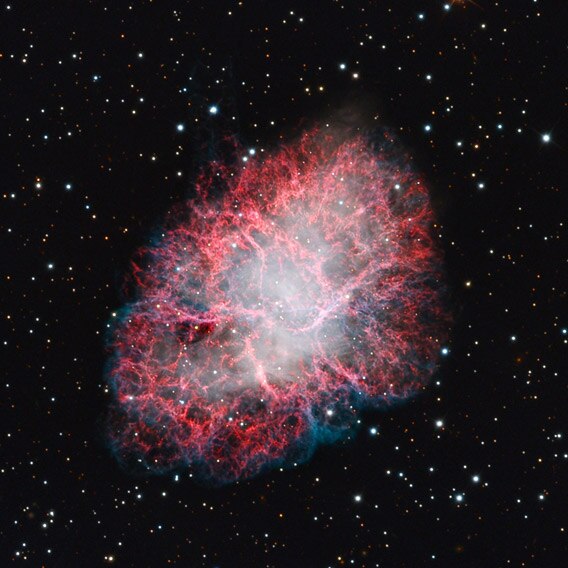Create a free profile to get unlimited access to exclusive videos, sweepstakes, and more!
The Heartbeat of an Exploded Star

A thousand years agoâin July 1054, to be somewhat more preciseâthe light from a cosmic catastrophe reached Earth. A massive star, probably 20 or more times the heft of the Sun, exploded. This titanic event was vast almost beyond human grasp: It released as much energy in a few weeks as the Sun will over its entire 10-billion-year lifetime.
The devastation was nearly total: Most of the star was torn apart, its octillion tons of matter blasted outward at a good fraction of the speed of light, while the very central core of the star collapsed to form a rapidly spinning white-hot neutron star. Now, 10 centuries later, the expanding debris is 100 trillion kilometers across, glowing from both the influence of the neutron starâs fierce magnetic field, and the violent collision of the filaments of the gas itself, creating epic shock waves in the material.
We call this cloud the Crab Nebula, and you can see it in the picture above, taken by my friend Adam Block using the 0.81-meter Schulman Telescope in Arizona. The total exposure time on this image was a whopping 17.5 hours, using several different filters to produce those glorious colors.
Amazing as the image is, thereâs another, subtler aspect of it that will cook your brain. That debris you see is still expanding, and quite rapidly. Because the Crab is tremendously far awayâ6,500 light-years or soâany motion is shrunk down to near invisibility. But weâve been observing it for decades, which is a pretty long baseline. That means that if you compare an earlier image to a later one, you can actually see the physical expansion of the supernova explosion.
Adam did this: He created the video below, which shows his image taken in 2012 compared to one taken in 1999 using the ESOâs Very Large Telescope.
Holy. Wow. Thatâs not a trick using exposures or magnification or anything like that. Keep your eyes on the stars and youâll see they are in the same positions in both frames; then pick a knot or filament in the nebula and you can see the material moving. To me it looks like a heart beating, especially given the gas cloudâs overall shape.
Iâve written about this visible expansion before; in fact a few years back when I was developing educational activities based on NASA satellites, I reworked an old classroom exercise where you could compare two images of the Crab and determine how fast itâs expanding and trace it back to determine how old it is. Astonishingly, you get the correct date to within a small margin of error!
Itâs easy to think of the sky as static, unmoving, and unchanging. Because most objects are so terribly far away, we donât notice the motion they undergo. But sometimes they move rapidly enough, and our technology is sensitive enough, that their velocity betrays them. And seeing that motion, as in the video, gives you a real sense of it. Remember, what youâre seeing is a superheated cloud of gas with five times the mass of the Sun screaming outward into space at speeds up to 1,500 kilometers per secondâwell over 3 million miles per hour!
The Universe is an amazing place. I love that we have such a wonderful chance to study it.


























